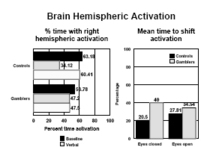Are the brains of pathological gamblers different from the brains of non-pathological gamblers? One way to approach this question is to examine EEGs (electroencephalograms) in the brains of pathological gamblers when their brains are activated by performing visual or verbal tasks. Ten years ago, Goldstein & Carlton studied EEGs of 8 subjects with a history of pathological gambling and 8 matched non-gambler controls1. Evidence supports the idea that different hemispheres of the brain (the left and the right) are associated with different types of tasks and skills. These researchers hypothesized that pathological gamblers’ capacity to switch from one to the other type of hemispheric activation would be meaningfully reduced, due to the compulsiveness of their disorder. Each subject was given 4 tasks to accomplish: one verbal task with eyes closed, one visual task with eyes closed, one verbal task with eyes opened, and one visual task with eyes closed. EEG signals from the left and right temporal placements were recorded while each subject was performing the 4 tasks. In addition, a neutral baseline recording was conducted while subjects were instructed to “relax”. Statistical analyses were performed on the right/left ratios for each subject and for each sequence of the experiment, followed by a logarithmic transformation to normalize the data. The results of this experiment reveal that control subjects performed the two eyes-closed tasks with typical shifts from baseline to the verbal task, and from the verbal to the visual task; however, gamblers did not have indications of shifts of laterality between the tasks (see graph below). Similarly, during the eyes-open tasks, gamblers did not experience statistically significant changes between the tasks. The two groups differed on the time it took between hearing the instructions and beginning the tasks; it took the gamblers significantly longer than the control subjects to manifest activation in either hemisphere. Goldstein & Carlton offer several possible explanations for these results: the gamblers may have ignored the instructions or not paid attention, or gamblers may have difficulty producing a shift of cerebral laterality in response to environmental demands. The implication of this observation is that gamblers may continue to bet, regardless of whether they are winning. What is not clear from this experiment is whether the brain characteristic determines the gambling behavior, whether gambling behavior changes the brain characteristics, or whether a third possibility accounts for these two characteristics.
Source: Goldstein, L., & Carlton, P.L. (1988). Hemispheric EEG correlates of compulsive behavior: The case of pathological gamblers. Research Communications in Psychology, Psychiatry, and Behavior, 13(1 & 2), 103-111.
This public education project is funded, in part, by The Andrews Foundation and the National Center for Responsible Gaming.
This fax may be copied without permission. Please cite The WAGER as the source.
For more information contact the Massachusetts Council on Compulsive Gambling,
190 High Street, Suite 6, Boston, MA 02110, U.S.





